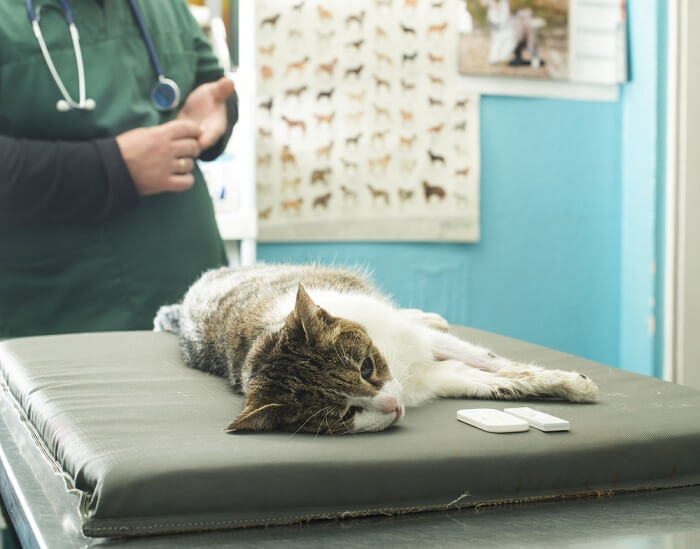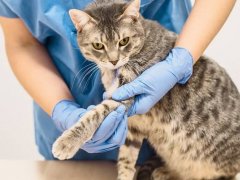
The aim of this article is to provide a good quality, accurate, easily understandable summary of the details about lily poisoning in cats, a common risk which is often not appreciated by cat owners, nor by general members of the public, and importantly, often not by florists who sell lilies both separately and in floral arrangements.
Quick Overview: Lily Poisoning in Cats




About Lily Poisoning in Cats
Lilies are beautiful, sweet-smelling plants that may be kept as houseplants, bought as cut flowers to be displayed in the home, or bought as a gift for others. They often have plentiful, luxuriant, green foliage, with large, pollen-rich, exotic flowers.
However, they should be kept only with great care in houses where cats live, because lilies are highly toxic to cats, causing rapid and often fatal kidney failure. Humans, dogs, and other animals are not affected by the toxic effects of lilies, and the danger to cats is not as widely known as it should be.
Prompt veterinary intervention can save the lives of cats suffering from lily toxicity.
What Are the Different Types of Lily?
Not all plants that include the word “lily” in their name are true lilies, and not all lilies are toxic to cats. It’s important to understand the terminology precisely.
In biological classification, a family contains a number of different genera (plural of genus), and a genus contains a number of different species, and finally, there may be subspecies or varieties of a species.
There is a family of flowers known as the Liliaceae family, and this includes more than 160 genera of plants: only genus Lilium (true lilies) and genus Hemerocallis (day lilies) are toxic to cats. This means that 158 of the genera in the Liliaceae family are non-toxic, and it’s the reason why it is very important to know exactly which plant or flower is being considered.
Toxic Lilies
The Lilium (true lily) species include L. lancifolium (tiger lily), L. orientalis (stargazer lily), L. longiflorum (Easter lily), L. asiatic (Asiatic lily or oriental lily), L. elegans (Asiatic hybrid lily), L. speciosum rubrum (rubrum lily), and L. umbellatum (wood lily, red lily, western lily).
The Hemorcallis (day lily) species include H. dumortierei/H. fulva (day lily), H. sieboldii (early day lily), and H. graminea (orange day lily).
Non-Toxic Lilies
Some plants that include the word “lily” in their name are not, in fact, true lilies, and they do not have the same highly toxic effect as true lilies.
Examples include:
- Peace Lily (Spathiphyllum species) (NB: these may contain oxalate crystals that can cause a different, far less serious toxicity)
- Lily-of-the-valley (Convallaria majalis)
- Calla Lilies (Zantedeschia species)
- Peruvian lily (Alstroemeria spp.)
Accurate plant identification is essential when considering the possible impact of plants or flowers in your home on cats.
Toxic Effects of Lilies
The precise poisonous agent contained in lilies has not yet been identified, but it’s thought to be a mix of so-called “steroidal glycoalkaloids” that have been isolated from all parts of the plant, including the leaves and pollen, but with the highest concentrations in the flowers themselves.
The toxic agents in lilies cause damage to the mitochondria in the cells of the kidneys and pancreas, with the most significant impact being proximal tubular cell degeneration in the kidneys, with all of the consequential signs of renal failure.
Ingestion of even small amounts of lily plants or flowers can lead to renal failure within 24 hours, followed by death a few days later if untreated. If a cat consumes multiple flowers, then death can follow within a few hours. If a cat is seen to even ingest part of a lily, they should be taken to their veterinarian for emergency treatment.
Some cats seem to be attracted to lilies, with a desire to eat them, and owners need to be aware that they may need to keep lilies out of the home completely, rather than just trying to keep them out of reach. Cats can be adept at climbing up, around, under and over obstacles to seek out objects that intrigue them.
Symptoms of Lily Poisoning in Cats

It’s crucial that affected cats are taken to the veterinarian at the early stage so that early, life-saving, veterinary care is given.
The symptoms shown by cats suffering from lily poisoning reflect the acute kidney failure caused by the damage to the kidneys and pancreas by the toxic components of lilies. The signs seen by an owner include loss of appetite, dullness, and vomiting, often within a few hours of exposure to lilies.
It’s highly important that affected cats are taken to the veterinarian at this early stage so that early, life-saving, veterinary care is given.
Even if no action is taken, these early signs may improve, giving an owner the illusion that the worst is over. However, under the surface, there is a significant kidney injury, and within the following day, the signs of illness will return, with increased severity, including severe dullness and collapse, repeated vomiting, drooling, loud vocalization, and neurological signs such as trembling, incoordination and sometimes seizures.
These signs are generally blamed on renal failure, but the ongoing pancreatic damage may also be contributing to the issues seen.
Diagnosis of Lily Poisoning in Cats
Often, there will be a history of known lily exposure followed by your cat becoming unwell, so a presumptive diagnosis of lily poisoning may be made at once. In other cases, a cat may present with signs that are suspicious, and the vet may need to go through a process of making an accurate diagnosis.
Contact with plant identification websites, a pet poison helpline, the animal poison control centre or the ASPCA poison advice library may be helpful.
Detailed History Taking
Your DVM veterinarian will discuss every aspect of your cat’s life, looking for clues that may include possible exposure to possible toxins, including lilies. Questions may be asked about your cat’s appetite, urination, and any other clinical signs that you may have noticed.
Physical Examination
Your veterinarian will check your cat over carefully, ruling out other causes of the signs that are being shown. A detailed neurological examination will be carried out if your cat is showing signs such as trembling, incoordination or seizures.
Routine Blood Tests and Other Laboratory Work
Your veterinarian is likely to suggest blood work, including the usual panel of diagnostic tests, such as hematology (complete blood count) and biochemistry profiles.
A pattern consistent with kidney damage and renal failure is likely to be seen, including elevations of creatinine, urea and phosphorus. Amylase and lipase may be elevated, reflecting damage to the pancreas. Elevated potassium levels (hyperkalemia) may be seen in severe cases.
Urine tests may also be carried out, with abnormalities including the presence of protein and glucose on a dip stick, over-dilute urine (isothenuria, with a specific gravity of 1.008 to 1.012), and the presence of kidney epithelial cells and casts in the urine sediment.
Other Investigations
- Ultrasound examination of the abdomen may reveal enlarged kidneys.
- An EKG may show the presence of a cardiac arrhythmia (irregular beat).
Treatment of Lily Poisoning in Cats

The prognosis depends on the level of lily exposure, the severity of the renal failure, and the promptness of veterinary intervention. Early treatment makes a significant difference.
Treatment of lily poisoning generally involves three aspects:
1. Decontamination
A specific treatment to remove any elements of the lily from the body, both inside and out, to prevent further absorption of toxins.
- Removal of lilies from the digestive system may be attempted by the induction of vomiting, gastric lavage, the oral administration of activated charcoal to prevent absorption from the intestines, and the administration of enemas to hasten the passage of lilies in the feces.
- If there are elements of lilies on the outside of the body (e.g. pollen dust sticking to the coat), a cat may be washed in shampoo to remove all traces of potentially poisonous material.
2. Immediate General Treatment
The initial priority is to stabilise any signs of lily poisoning that the cat is showing:
- Anti-emetics to stop repeated vomiting
- Anti-seizure medication if a cat is suffering from twitching or seizures
- Intravenous fluid therapy to minimise the impact of the toxins on the kidneys and pancreas
- Medication as needed to control electrolyte abnormalities (such as elevated potassium levels)
- Other medications as needed to minimise any other signs the cat is showing
3. Longer-Term Treatment
- As long as a cat is successfully passing urine (i.e. the kidneys have not “closed down”), then iv fluids should be given, initially to correct dehydration, and continued for 2 – 3 days to undertake a process known as fluid diuresis. This flushes out the kidneys, maximising the removal of toxins via the urine, and supporting kidney function.
- Peritoneal dialysis (a process of using the abdominal cavity as a type of natural dialysis machine) has sometimes been undertaken.
- Full hemodialysis (similar to the dialysis offered to human patients with kidney failure) is theoretically possible, as is full scale renal transplantation if a cat enters complete renal failure.
- Cats with renal failure can develop inflammation and ulceration of the stomach and digestive tract, and gastric protectants and antacids are often used to prevent and treat this issue.
- Other treatments can include special renal diets to offer appropriate nutritional support, as well as medication such as phosphate binders if the cat is suffering from hyperphosphatemia.
Prognosis
The prognosis depends on the level of lily exposure, the severity of the renal failure, and the promptness of veterinary intervention. Early treatment, within hours of ingestion, makes a very significant difference, In one study, this helped 90% of poisoned cats to survive and return to a normal healthy life without long-term kidney failure.
Prevention of Lily Poisoning in Cats
Lilies should be kept out of the reach of cats at all times. Arguably, lilies should not be allowed in the same homes as cats, to remove all possible risks.
Conclusion
Lily poisoning is a specific diagnosis caused by ingestion of parts of the lily plant by cats. Once the problem has been identified, intensive treatment can be life-saving.
Also Read: Poisoning In Cats: Causes, Symptoms, and Treatment
Frequently Asked Questions
What are the symptoms of lily poisoning in cats?
After ingestion of lilies, cats show the signs of renal failure, including dullness, inappetence, and vomiting, as well as other signs such as collapse, seizures, and more.
Can cats die from lily poisoning?
In severe cases of lily poisoning, death is possible; prompt treatment of poisoned cats is essential.
How long does it take to get lily poisoning?
Any ingestion of all parts of the lily plant can cause rapid signs of toxicity, and early treatment is essential to save a cat's life.
How does ingestion of lilies affect cats?
The poisonous component of lilies causes damage to cells in the kidneys and pancreas, leading to rapid onset kidney failure that needs urgent treatment
Are humans at risk from lily poisoning?
Lilies do not cause toxicity in dogs nor in humans; this is a specific feline problem.







